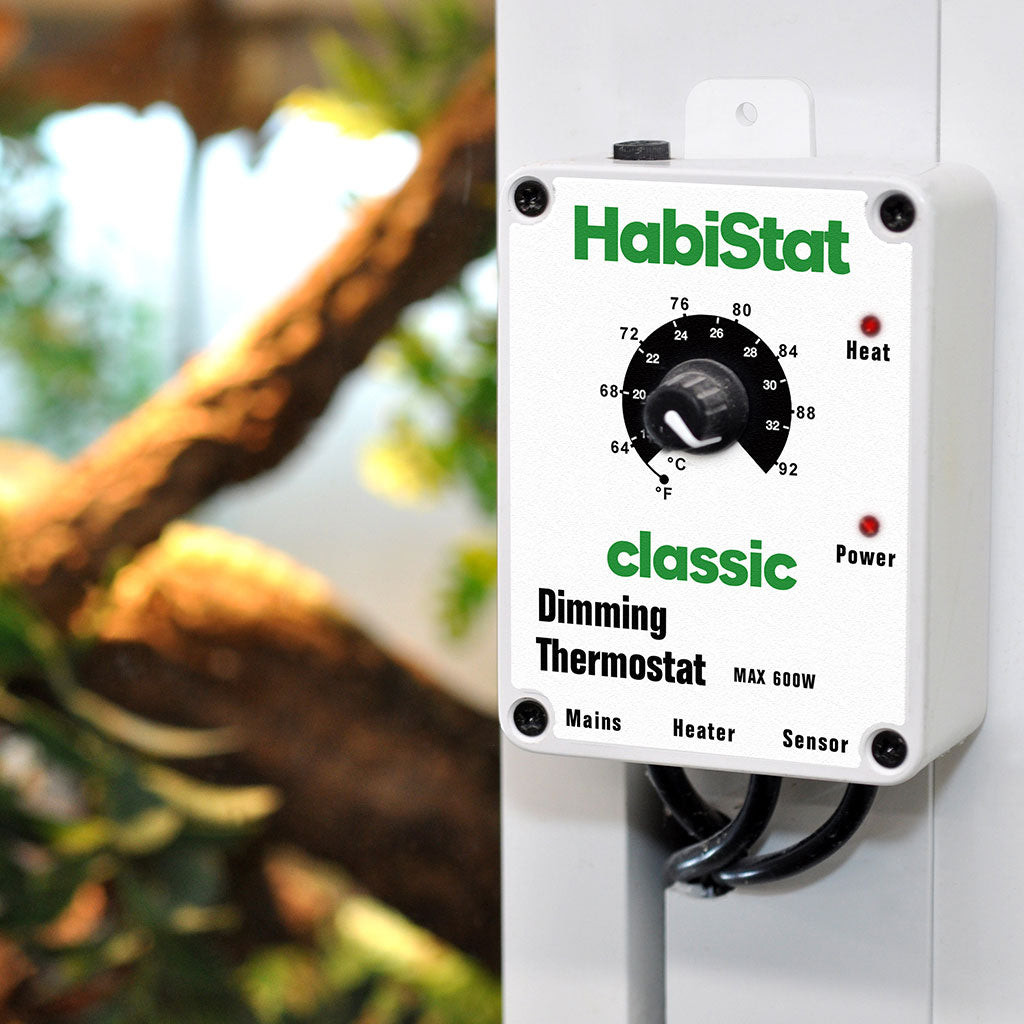At Internet Reptile, we're often asked whether it's really necessary to purchase a thermostat... in this post we'll explain why the answer is almost certainly always yes and the benefits correctly installing a reptile thermostat in your reptiles vivarium will give both you and your pets.
We'll then expand further on the different types of thermostats that are available, how they operate and which heaters they are designed to control.
Why use a Reptile Thermostat?
Reptiles are cold blooded, this means that they regulate their body temperature using their environment: it's for this reason we have to incorporate heating into the design of your pet reptiles vivarium. Simply providing hot or cold isn't good enough though, the temperatures we provide must resemble that of the environment your pet reptile originally inhabited.
Even the most carefully selected heaters have the potential to overheat significantly in certain circumstances (e.g. that 60w light bulb that runs 'about right' most of the time, can turn a vivarium into an oven on a hot summers day).
As its most basic and essential function, a thermostat will act as a safety cut out for your heater; preventing over heating and minimising the risk of fire.
Controlling the temperature of your heater will also make for a more natural, comfortable and stress free enclosure.
Which Reptile Thermostat should I choose?
With so many reptile thermostats to choose from, it can often seem difficult to make the right decision. All the reptiles thermostats we sell are plug and play and require no special wiring or electrical knowledge; the thermostat will plug into the mains and your heater(s) into a socket attached to the thermostat.
Given that the reptile thermostat you choose can literaly make the difference between life and death; we'd recommend ensuring you choose a top quality brand such as Habistat or Microclimate... both these manufacturers were the first in the UK to produce specialist reptile thermostats and offer up to 5 years warranty on their reptile thermostats to give you complete peace of mind.
At Internet Reptile we are proud to be official retail partners to both brands giving you an unrivalled support service, and like all the reptile products we sell our Habistat and Microclimate Reptile Thermostats are available with our lowest price promise.
As well as brand, you should consider the type of thermostat you need for your heat source. These can be broken down into 3 types of reptile thermostat
- On/Off Thermostats
- Pulse Proportional Thermostats
- Dimming Thermostats
Some more advanced thermostats can be switched between modes, but the basic technology remains the same. Read on to find out more about each type of reptile thermostat and what type of heater they are most suited to control.
On/Off Reptile Thermostats
The on/off reptile thermostat is the most basic, and often cheapest, type of reptile thermostat available. Once your heater has warmed up, and starts to exceed the preset temperature, the thermostat will turn off your heater. As the temperature drops below the preset temperature, the thermostat will turn back on the heater and the cycle continues.
Pros:
- Cost effective
- More fluctuation in temperature than other thermostats
- Cannot be used with any type of light emitting heater
Ideal For:
- Heat Mats
Top Picks:
- Microclimate MiniStat 100
- Habistat Mat Stat Reptile Thermostat
Pulse Proportional Thermostats
Once a heater has reached the desired temperature, a pulse proportional thermostat (pulse stat) starts to send short, regular "pulses" of electricity to the heater. The significantly shorter cycle time, as compared to an on/off thermostat, means that temperatures remain very steady as fluctuations are ironed out.
Pros:
- Increased precision
- Minimal fluctuation in temperatures
- Higher max loads possible
- Choice of standard or high range thermostats
Cons:
- More expensive than on/off thermostats
- Cannot be used with light bulbs
Ideal For
- Heat Mats
- Ceramic Heaters
- Incubators
Top Picks
- Microclimate B2 Pulse Thermostat
- Habistat Pulse Thermostat
Dimmer Thermostats
A dimming reptile thermostat is one of the most versatile and accurate thermostat types on the market. Compatible with almost all heaters (although you do have to check the minimum load on some models), they work by regulating (lowering and increasing) the amount of electricity being supplied to the heating.
When used with a light bulb, you will see the bulb dim and then brighten as the thermostat regulates the temperature, but they can also be used with none light emitting heaters too.
Pros:
- Precision
- Little fluctuation in temperature
- Suitable for use with Light Bulbs
- Choice of standard and high range models
Cons:
- More expensive than other types of thermostat
- Some models have a min load of 40w (only an issue with low wattage heaters such as heat mats)
Ideal for:
- Light Bulbs
- Deep Heat Projectors
- Ceramic Heaters
- Heat Mats and Cables (see min load)
- Incubators
Top Picks
- Microclimate B1 Dimmer Thermostat
- Habistat Dimmer Thermostat
Smart Thermostats
Whilst simplicity can be an asset when choosing a new reptile thermostat, the functionality of good quality smart thermostats can be hugely beneficial. The first point to make is that these thermostats will still fall into the on/off, pulse or dimming functionality bands we've already outlined.. they are NOT a different type of thermostat.
What makes a lot of these models unique is their ability to switch between modes which future-proofs the thermostat, should your needs or reptiles change.
Additional features such as temperature logging, automated day/night cycles, lighting or humidity control, wifi access and more make smart reptile thermostats well worth a look.



